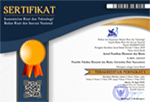RASIO KEUANGAN DAN PREDIKSI FINANCIAL DISTRESS
DOI:
https://doi.org/10.33633/jpeb.v2i2.2042Abstract
The purpose of this research is to understand the effect of financial ratios in predicting the possibility of financial distress on companies listed on Sri Kehati index in a row of 2009-2016. This study uses the financial ratios proxied by return on assets, return on capital, net profit margin, P / E ratio, and asset turnover as independent variables. Meanwhile, the financial distress proxied by Z-score is a dependent variable. The population of this study is all companies listed on the index of Sri Kehati in 2009-2016 and listed on the Indonesia Stock Exchange. The sample of this study took nine companies with purposive sampling method and the study period is for eight years in a row (2009-2016). Logistic regression method used in this research. The results show that ROA, ROE and PER have a significant effect on financial distress. Meanwhile, NPM and ATO have no significant effect on financial distress.Keywords: Financial Ratio;Financial DistressReferences
Abidin, Zainal. 2013. Pengaruh Rasio Keuangan Terhadap Perubahan Laba Pada Perusahaan yang Go Public di Bursa Efek Indonesia. Jurnal Ilmu & Riset Akuntansi. Vol.2 No. 5.
Akerlof, George A. 1970. The Market for 'Lemons': Quality Uncertainty and the Market Mechanism. Quarterly Journal of Economics (The MIT Press) 84 (3): 488–500.
Altman, Edward I. 2000. Predicting Financial, Distress of Companies : Revisiting The Z-score and Zeta ® Models. New York University: Stern School of Business.
Brigham F. Eugene dan Joel Houston. 2013. Dasar – Dasar Manajemen Keuangan: Assetials Of Financial Management. Jakarta: Salemba Empat.
Choirina, PutriMutia. 2015. Analisis Faktor-Faktor Yang Mempengaruhi Probabilitas Financial Distress Perbankan Indonesia. Diponegoro Journal of Accounting.Vol. 4 No. 2, Hal 1-9.
Christananda, Claudia, dkk. 2017. Analisis Current Ratio dan Net Profit Margin untuk Memprediksi Kondisi Financial Distress Perusahaan (Studi pada Perusahaan Tekstil dan Garmen yang Terdaftar di Bursa Efek Indonesia Periode 2010-2015). e-Proceeding of Management : Vol.4, No.1.
Haq, Syahidul, Muhammad Arfan, & Dana Siswar. 2013. Analisa Rasio Keuangan dalam Memprediksi Financial Distress (Studi pada perusahaan yang terdaftar di Bursa Efek Indonesia). Jurnal Akuntansi. Vol. 2.Th.1.
Marwati, Dian. 2012. Analisis Rasio Keuangan untuk Memprediksi Kondisi Financial Distress pada Perusahaan Manufaktur yang Terdaftar di Bursa Efek Indonesia. Jurnal Fakultas Ekonomi dan Bisnis Universitas Dian Nuswantoro. Semarang: Universitas Dian Nuswantoro.
Mas’ud, Imam dan Reva Maymi Srengga. 2012. Analisis Rasio Keuangan Untuk Memprediksi Kondisi Financial Distress Perusahaan manufaktur Yang Terdaftar Di Bursa Efek Indonesia. Jurnal Akuntansi Universitas Jember, Vol 3 no 2, h. 139- 159.
Noviandri, Tio. 2014. Peranan Analisis Rasio Keuangan Dalam Memprediksi Kondisi Financial Distress. Jurnal iImu Manajemen. Vol. 2, No. 4, Halaman 1–11.
Nurcahyono, Ketut Sudharma. 2014. Analisis Rasio Keuangan Untuk Memprediksi Kondisi Financial Distress. Management Analysis Journal. Semarang: Universitas Negeri Semarang.
Prastowo, Dwi. 2011. Analisis Laporan Keuangan Konsep dan Aplikasi. Edisi Ketiga. Cetakan Pertama. Yogyakarta: UPP STIM YKPN.
Putra, Yogi Agung Permana. 2017. Analisis Rasio Keuangan untuk Memprediksi Kondisi Financial Distress Perusahaan Manufaktur yang Terdaftar di Bursa Efek Indonesia. E-Journal S1-Ak Universitas Pendidikan Ganesha. Singaraja: Universitas Pendidikan Ganesha.
Saleh, Amir dan Bambang Sudiyatno. 2013. Pengaruh Rasio Keuangan Untuk Memprediksi Probabilitas Kebangkrutan Pada Perusahaan Manufaktur yang Terdaftar di Bursa Efek Indonesia. Jurnal Dinamika Akuntansi Keuangan dan Perbankan, Vol 2, No.1, 82-91.
Subramanyam, K.R. dan John J. Wild. 2010. Analisis Laporan Keuangan. Edisi Kesepuluh. New York: McGraw-Hill.
Sudana, I Made. 2011. Manajemen Keuangan Perusahaan Teori & Praktik. Jakarta: Erlangga.
Widati, Listyorini Wahyu dan Bayu Adhi Pratama. 2014. Pengaruh Current Ratio, Debt to Equity Ratio, dan Return on Equity Untuk Memprediksi Kondisi Financial Distress. Jurnal Universitas Stikubank. Semarang: Universitas Stikubank.
Yudiawati, Rike dan Astiwi Indriani. 2016. Analisis Pengaruh Current Ratio, Debt to Total Asset Ratio, Total Asset Turnover, dan Sales Growth Ratio Terhadap Kondisi Financial Distress. Diponegoro Journal of Management. Vol. 5 No. 2, Hal 1-13.
Zaki, E., Bah, R., danRao, A. 2011. Assesing Probabilities of Financial Distress of Banks in UAE. International Journal of Managerial Finance.Vol. 7 No. 3, 305.
“Merger Tiga Bank Pilihan Dilematisâ€. [Surat Kabar]. Pikiran Rakyat. 6 Januari 2010, h.8.
Downloads
Published
How to Cite
Issue
Section
License
The copyright of the received article shall be assigned to the journal as the publisher of the journal. The intended copyright includes the right to publish the article in various forms (including reprints). The journal maintains the publishing rights to the published articles.
This work is licensed under a Creative Commons Attribution 4.0 International License.



.png)









